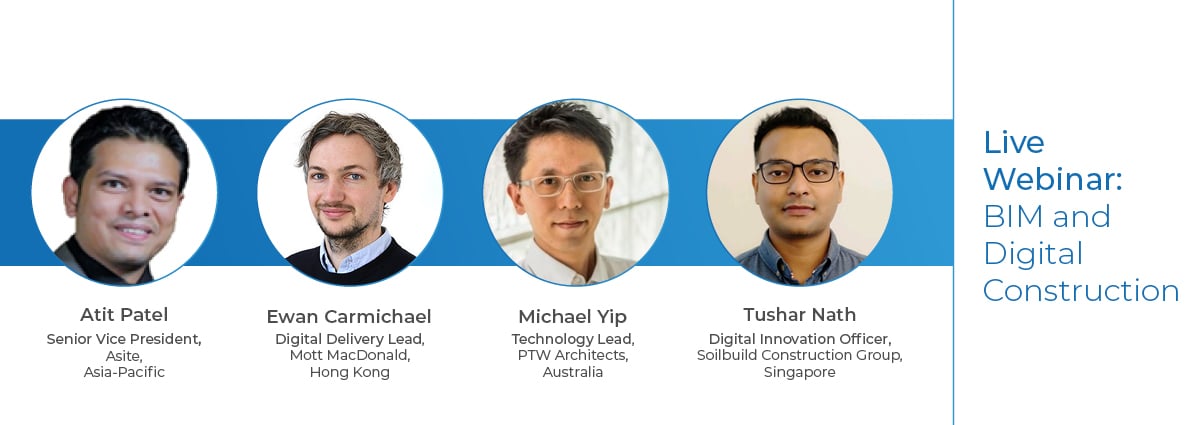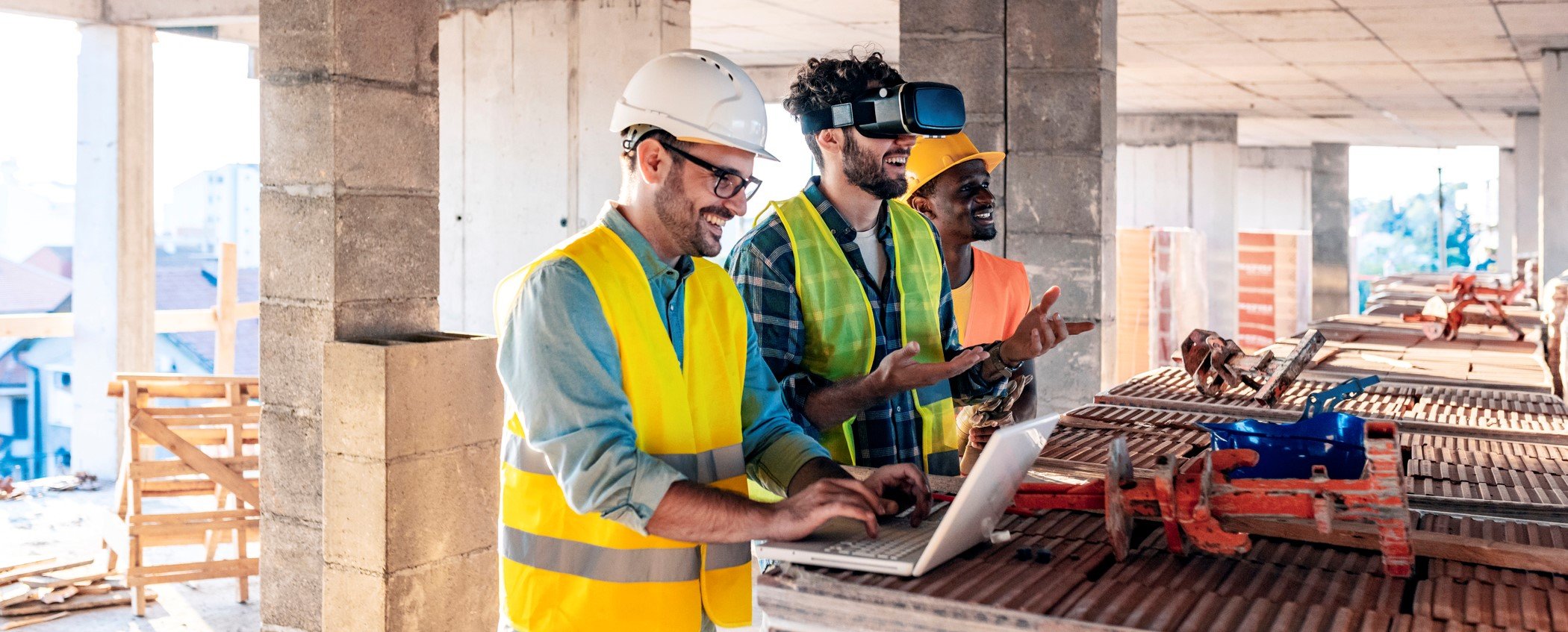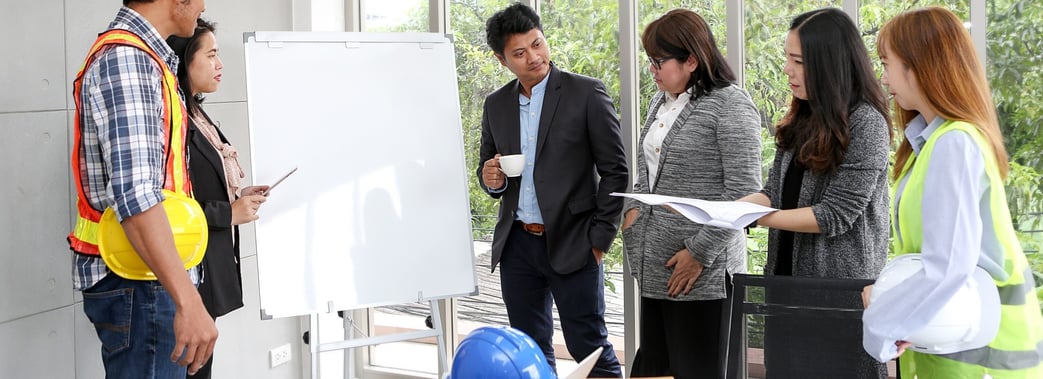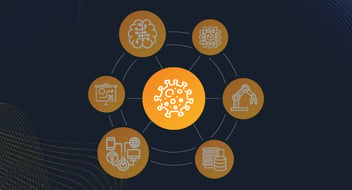
Ensuring better collaboration across the construction industry is the key to higher productivity and greater stability. With technology paving the way for improved collaboration on projects, it is crucial to leverage digital solutions such as BIM to enable the construction industry to maximise collaborative approaches to working.
Over the past year, the construction ecosystem has witnessed accelerated disruption when it comes to embracing new technologies, especially given the shift to a “new normal” caused by the biggest pandemic the world has ever faced. However, traditional barriers still remain in place.This week our SVP for APAC, Atit Patel, hosted an exciting panel discussion on BIM and digital construction. The webinar brought together industry experts, including Ewan Carmichael, Digital Delivery Lead, Mott MacDonald, Hong Kong; Michael YIP, Technology Lead, PTW Architects, Australia; and Tushar Nath, Digital Innovation Officer, Soilbuild Construction Group, Singapore; to explore how organizations must change and adapt their strategies and business models to optimize the opportunities digital technologies bring.

Here are three key takeaways from the discussion.
COVID-19’s Impact on Digital Transformation
With a specific focus on Hong Kong, Singapore, and Australia the participants spoke about how they believe the global COVID-19 pandemic has impacted the rate of digital transformation in the construction industry.
Both Michael YIP and Asite SVP for APAC, Atit Patel noted the uptake of people using technology since the onset of the pandemic. Michael states that working remotely has forced teams to become digitally enabled and that the immediacy of the pandemic has “helped push the industry forward”. A similar view is taken by Atit who has seen people once hesitant to use technology realize the benefits of it, causing a change to their mindset, “things they thought would hinder their day-to-day job is actually supporting them”.
This forced adoption of technology is not only being witnessed in remote working but also in model coordination. It is not only meetings that are moving online but systems, Michael notes VR class detection as now becoming a lot more common.
Ewan Carmichael also recognizes this shift but notes the change in the use of such technologies. He states his global team have been advising clients on how they can use digital tools to operate their infrastructure in a low risk way including pedestrian modelling in airports to incorporate social distancing, showcasing new measures will impact how they operate.
Tushar Nath instead discusses the levels of digital disruption already present in the industry prior to the pandemic. He remarks in coming years “fundamental change brought in by the changes in the market characteristics, at least in Singapore”. He states, rather than adopting a particular technology three factors will bring about substantial change in our sector; industrialization, new materials, and digitalization of processes.

People Preventing Digital Transformation
Despite the push to adopt digital tools and techniques, barriers remain in the way, preventing these technologies from reaching their full potential within the construction industry. Tushar identified three key aspects blocking the implementation of digital solutions across the project lifecycle; fragmentation, lack of replication, and transience. He stated that fragmentation meant “construction processes are fragmented along the value chain” as “each step of the value chain involves multiple stakeholders so implementing digital solutions requires a high degree of coordination among different organizations”. Construction projects nearly always being “one of a kind” and the project team changing from project to project results in difficulties in bringing BIM technologies along the process from design to construction to facility management. Ultimately, these barriers ensure introducing the changes needed for the full-scale transformation required remain challenging.
Adding to this, both Ewan and Michael spoke about people and cultural change being the biggest obstacle. Despite digital tools, including BIM, being in operation for a many years, it remains difficult for people to adopt and embrace them. As Ewan states “blockers are usually the people afraid of change”.
Both Ewan and Michael spoke about the ways in which this can be overcome, with Michael stating getting everyone on the same platform and enabling open communication is the first step. He also notes training and investment in this change as the most important factor, while data ownership and risk management are two areas which need to be resolved in order to make individuals more comfortable with adopting digital techniques.

Data is Key – How do we use it Better?
All three participants noted that data is a resource which is becoming increasingly impactful on projects and will continue to do so.
As Atit explained, one common occurrence within organizations prior to using a cloud platform is that their information is siloed and does not speak to each other. Asite advises projects to use a centralized platform to get common view. Simple steps can be introduced to make sure all project participants are working from common data which is held in one central repository, ready to be used across the asset lifecycle including the handover of a finished asset.
This, as Ewan explains, allows teams to utilize data to understand project performance, trends, and deliverables against programs. Speaking about Mott MacDonald’s own program “Switch” and its impact, he stated the use of such techniques coupled with report, insights and even geographical views provide a good message to clients, allowing them to see how a project is progressing and how it’s performing.
Michael supports this, however, mentions the need for data to come in a specific format that is open and shareable across all users in order to be utilized effectively. He suggests at the earlier phases of a project, stakeholders need to “work together to figure out what they want out of the model and plan ahead”. Michael suggests a “good brainstorming session up front” is necessary to design a model in such a way it can carry from design through to maintenance. A common language is important to make sure information goes to different stakeholders in the right format.

Final Thoughts
While the COVID-19 pandemic has accelerated the adoption of digital tools and techniques in many cases and the benefits of adopting these techniques to harness data and utilize it to improve processes and operation are obvious, digital transformation remains reliant on the will of individuals.
It is clear from the discussion that people, as stakeholders and their lack of engagement with one another, and their unwillingness to adopt digital tools and techniques, remain a barrier which the industry needs to overcome.
In order to reap the full rewards digital transformation can offer, the construction industry will need to put the enablers in place to survive in the new world and choose their own transformation approach by investing in on-site automation, digitisation of processes and end-to-end adoption of BIM.
Please click here to register and watch the full panel discussion.
4 minute read
Asite Insights in your inbox.
Sign up for product news and our latest insights published monthly. It's a newsletter so hot, even global warming can't keep up.



